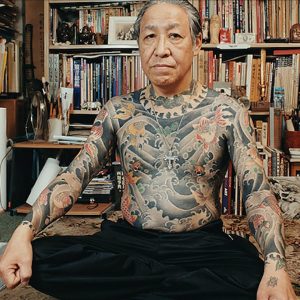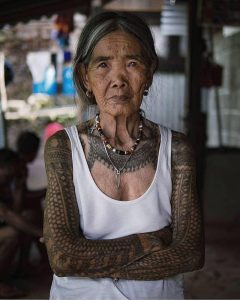Legendary Artists Around the World
While we still cannot hop on a plane and go, or even drop down to our local tattoo studio, we will keep traveling in our imagination and anticipation. Today we take a look at two utter legends within traditional tattooing who are still practicing their art to this day.
Icon of Yokohama and Irezumi

If you are serious about a full Irezumi body-suit and you have the cash to spare – not to mention the time to hang around Japan – there is no one more iconic than Yokohama’s Horiyoshi III. Apprenticed to legendary artist Yoshitsugu Muramatsu, the now 74-year-old horishi was born Yoshihito Nakano right after the end of WWII. His work is the epitome of Japanese folkloric and traditional motives. He himself has a full-body suit, crafted by the son of his teacher.
Following a friendship with American icon Don Ed Hardy in the 80s, Horiyoshi III reportedly began doing his outlines with an electric tattoo machine. The rest is still done with Tebori technique – by hand and painstakingly. Unfortunately, Horiyoshi III has recently been taken ill with a kind of autoimmune diseases. While we wish the master a speedy recovery, his son – who has been granted the honorific Horiyoshi IV, works in the space above the family-run Yokohama Tattoo Museum. Just be prepared – a traditional body-suit can take up to 500 hours to complete.
‘The creatures I draw only come alive on somebody’s skin. This is why I never show my designs as so-called art. I draw simply for fun and to have samples to show my clients so they can pick a new design. The creatures depicted take the person’s breath away once they are on his or her skin — and then the two start breathing together, in unison. Human history alters the look of the animals and plants I paint, and when the person wearing them dies, so too do they,’ Horiyoshi III was quoted in the Japan Times Online in 2007.
As traditional as it gets in the Philippines
 We cannot mention masters of their traditions without talking about Whang-Od Oggay of the Kalinga tribe in the Philippines. She is the country’s oldest mambabatok – traditional tattoo artist. To get to her takes a 14-hour journey from Manila – including a two-hour trek for the final leg. Her village of Buscalan is home to a couple of hundred families.
We cannot mention masters of their traditions without talking about Whang-Od Oggay of the Kalinga tribe in the Philippines. She is the country’s oldest mambabatok – traditional tattoo artist. To get to her takes a 14-hour journey from Manila – including a two-hour trek for the final leg. Her village of Buscalan is home to a couple of hundred families.
The tattoos were traditionally awarded to men headhunters, after they had earned them through a kill, or as aesthetic accessories for women. Whang-Od uses a thorn from a citrus (some say pomelo, some lime, some lemon) tree, a foot-long bamboo stick, charcoal from the soot of a pot, and water.
The 103-year-old woman is reportedly still tattooing. But just in case you cannot make it there before she decides to retire (when that will be she says will depend on her eye-sight), her two grandnieces have been learning the craft from her, just as Whang-Od did from the age of 15. And while the experience may have been recreated by a fair amount of random travel-YouTubers, it is still an incredible piece of tattoo history to carry the legacy of the craft and your adventures with you forever. It also makes for an incredible stop on a South East Asian itinerary.
While the tourism Whang-Od’s fame has brought her little corner of the world is not without its problems, efforts have been done to help preserve the culture and take care of environmental challenges such as trash left behind by tourists are being made. Whang-Od herself has said she is happy that people make the journey and that they bring money to the villagers who otherwise have to work very hard in the fields.
